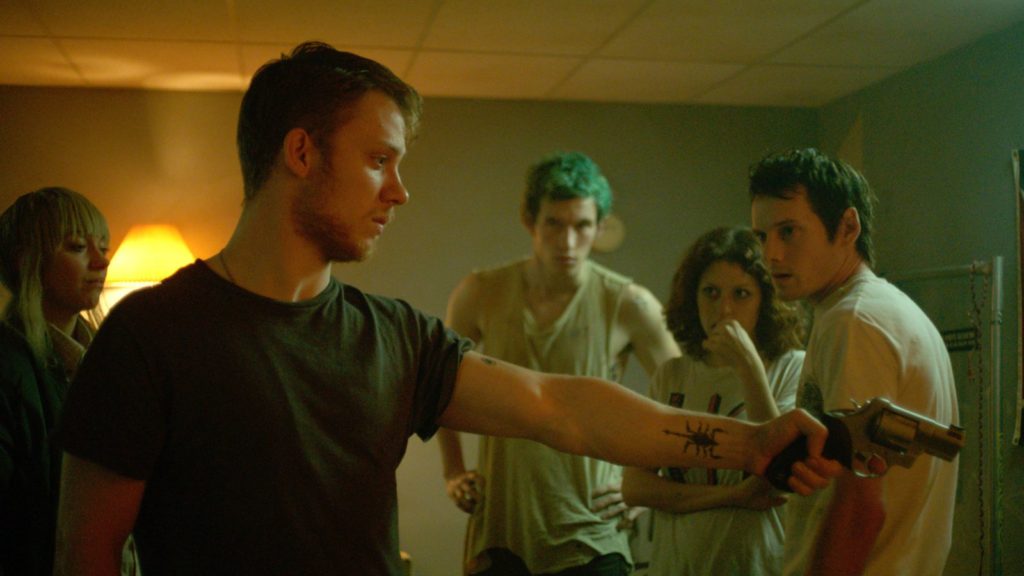Green Room (2016): Written and directed by Jeremy Saulnier. Starring: Anton Yelchin, Imogen Poots, Alia Shawkat, Patrick Stewart, Joe Cole, and Callum Turner. Rated R for violence and action. Running time: 95 minutes.
***SPOILER ALERT: Major plot details ahead.***
I’m fascinated by film violence, particularly as someone who abhors real life violence. I’m fascinated by its causes, by its justifications, by the ways filmmakers choose to portray it: to repulse us, distance us, or immerse us in it.
Writer/director Jeremy Saulnier has always been fascinated by these themes; his protagonists are often thrust into violent situations with little to no choice in the matter. Because of this, they are woefully unprepared to commit and endure (much less contemplate) violence, unprepared for its physical and psychological consequences.
The “Ain’t Rights”, the band at the center of Green Room, most assuredly fall into this category. This despite their hardcore image, their punk rock trappings, and their sheer audacity to open with the Dead Kennedys’ “Nazi Punks F*** Off” at a neo-Nazi bar. They may live on the edge of poverty (living out of their van, siphoning gas from parked cars when necessary), but it seems fairly clear these four kids were raised in safe, privileged suburbia. When they stumble upon the aftermath of a murder in the Nazi bar, their true colors are revealed. They are babes in the woods, and the trees have teeth.
And yet…something’s off kilter about the egregious acts committed here. Make no mistake; the carnage onscreen proves messy indeed. But the methods employed, whether they be box cutters, machetes, or even pit bulls, are ultimately practical. Those pit bulls are vicious, yes, but they have been trained explicitly for one purpose: go for the throat. They are employed at the time because bullets will leave a crime scene that is more difficult to clean. Yes, there are a few instances of sadistic pleasure from our antagonists, but they are short-lived; the tools are there to get the job done, plain and simple.
In addition to highlighting violence as pragmatism, Green Room contains scenes of deliberately awkward savagery. Characters we come to know do not die “honorably” here; they die screaming, both in pain and in fear. Or take the absurd manner in which Darcy Banker (Patrick Stewart) is gunned down, attempting a last stand that ends in anticlimax. Despite his mighty efforts to spite his killers, he can only grunt and limp through his last moments, succumbing to gunshots before lamely firing off a useless round. These scenes chafe at the idea of violence as a graceful or fluid thing. Saulnier is concentrating on the messiness of film violence, not just in fluids spilled, but in actions committed. The film reminds us that real life murder and death rarely achieve the romanticism of the movies.
Speaking of romanticism, how many films have we seen in which characters commit violence with firm intention and confidence? Think James Bond, The Man with No Name, Beatrix Kiddo. These are not the protagonists of Green Room. For the band members, every action they commit seems unintentional, even when it’s on purpose. Guitarist Sam (Alia Shawkat) rushes every open door with a fire extinguisher, screaming wildly, in the hopes she will blind her attackers and not have to resort to more lethal possibilities. Bassist Pat (Anton Yelchin) kills one neo-Nazi with a machete to the neck, then dazedly stares at his work (the man had attempted a post-kill quip, and the film punishes him for it). Only their ally Amber (Imogen Poots) approaches her tasks with coolness, likely stemming from a past fraught with trauma and tragedy. Yet even in her scenes, Saulnier refuses to let us feel a sense of catharsis; each death she causes is simply a stepping stone toward her survival.
Saulnier doesn’t portray film violence in expected ways; he focuses on its chaos and far-reaching consequences. In so doing, he makes Green Room graphic but never exploitative; the images shock and awe but never thrill and excite. In the right directorial hands, violence still has the power to appall us, to move us. Saulnier robs movie violence of its mysticism while still retaining its dire consequences.
Would-be filmmakers? Experienced filmmakers? Take a good, long look.
